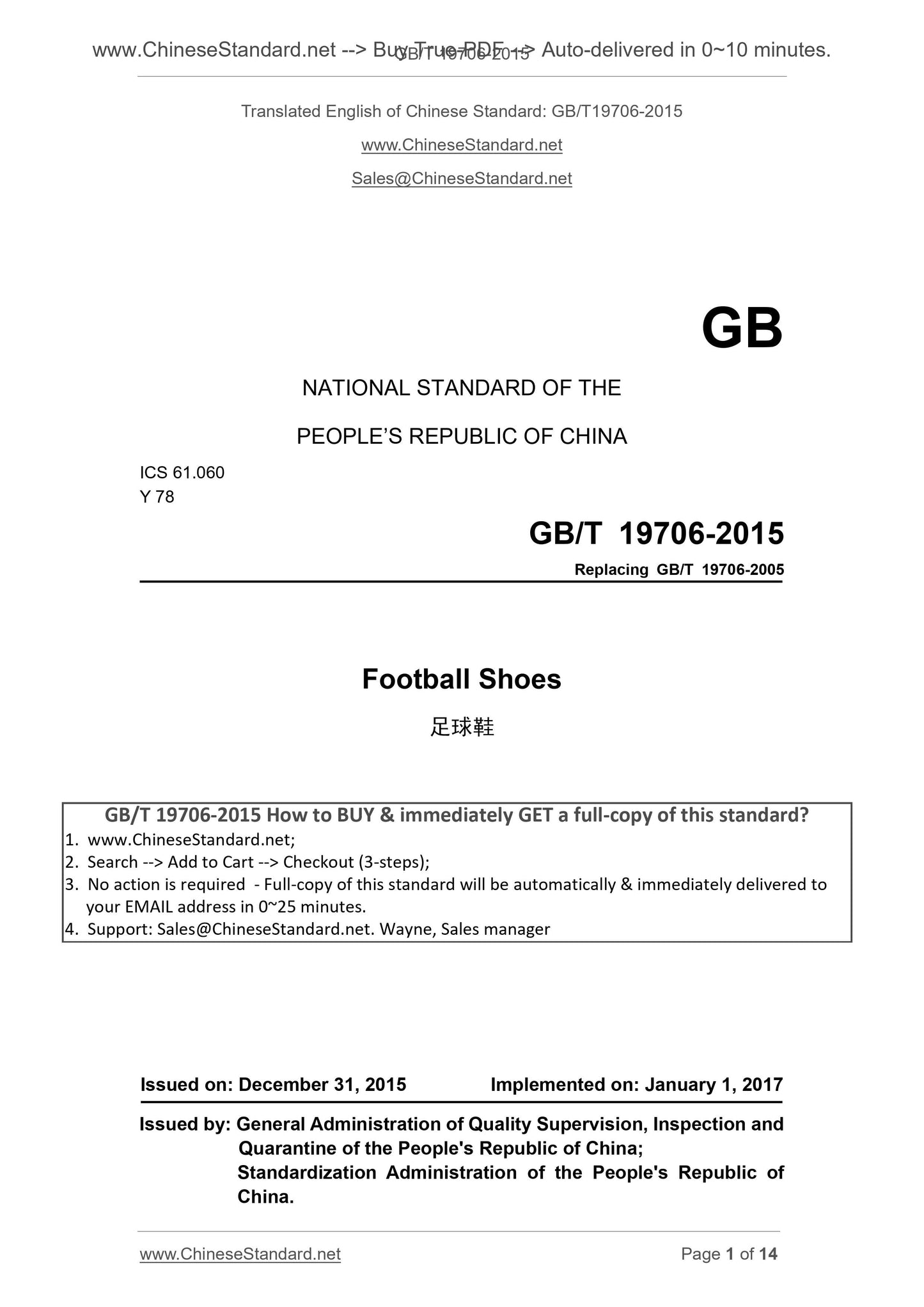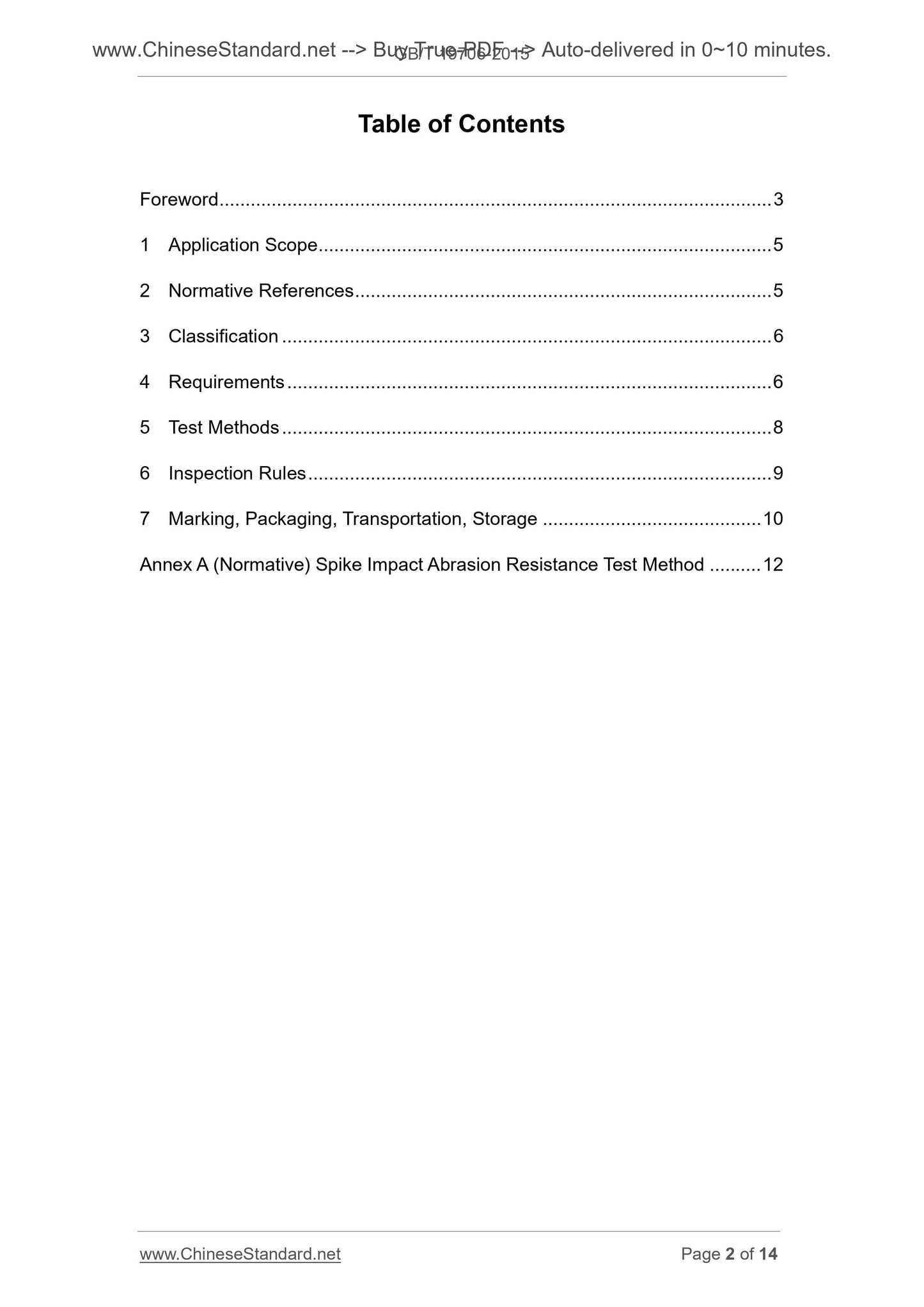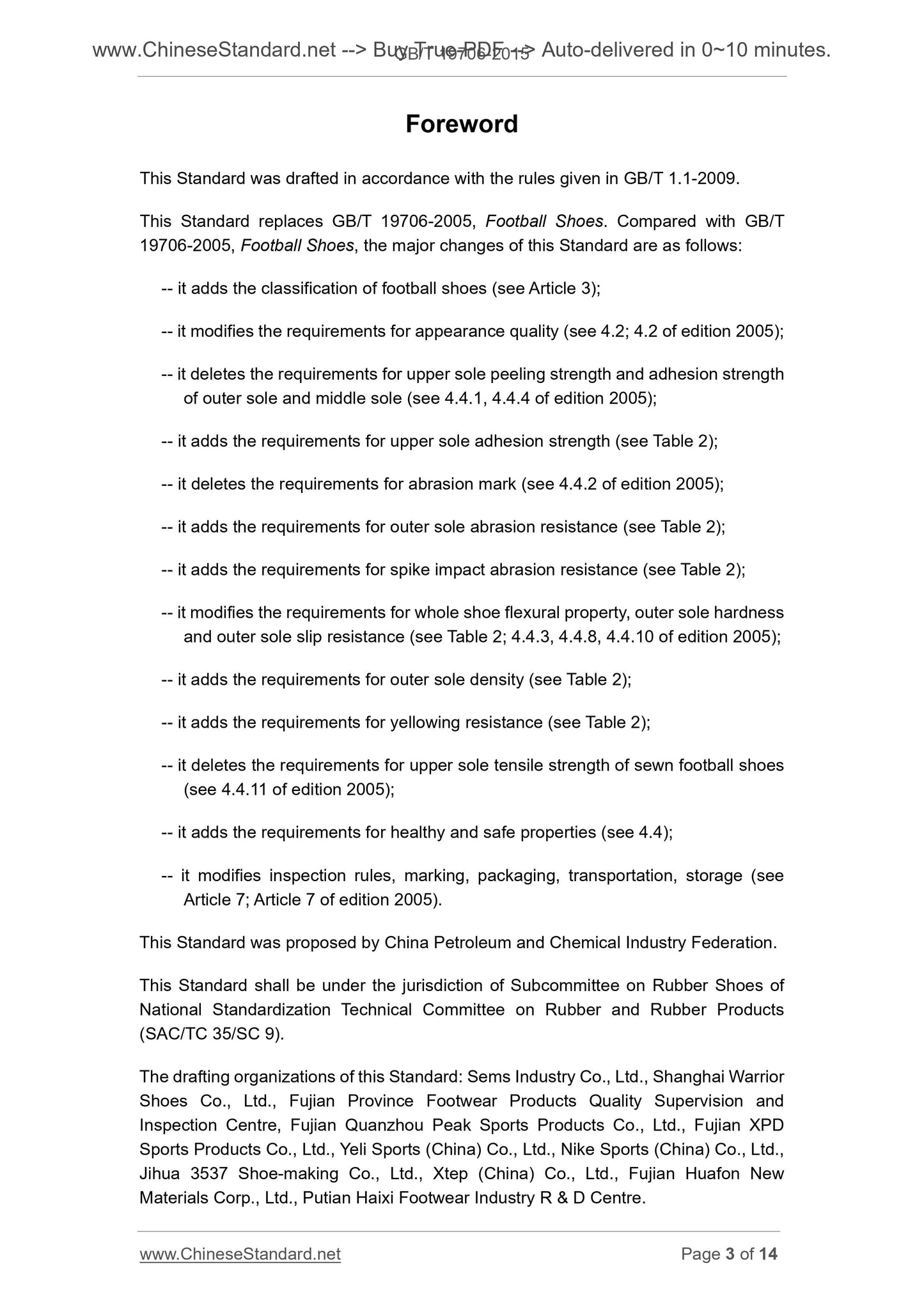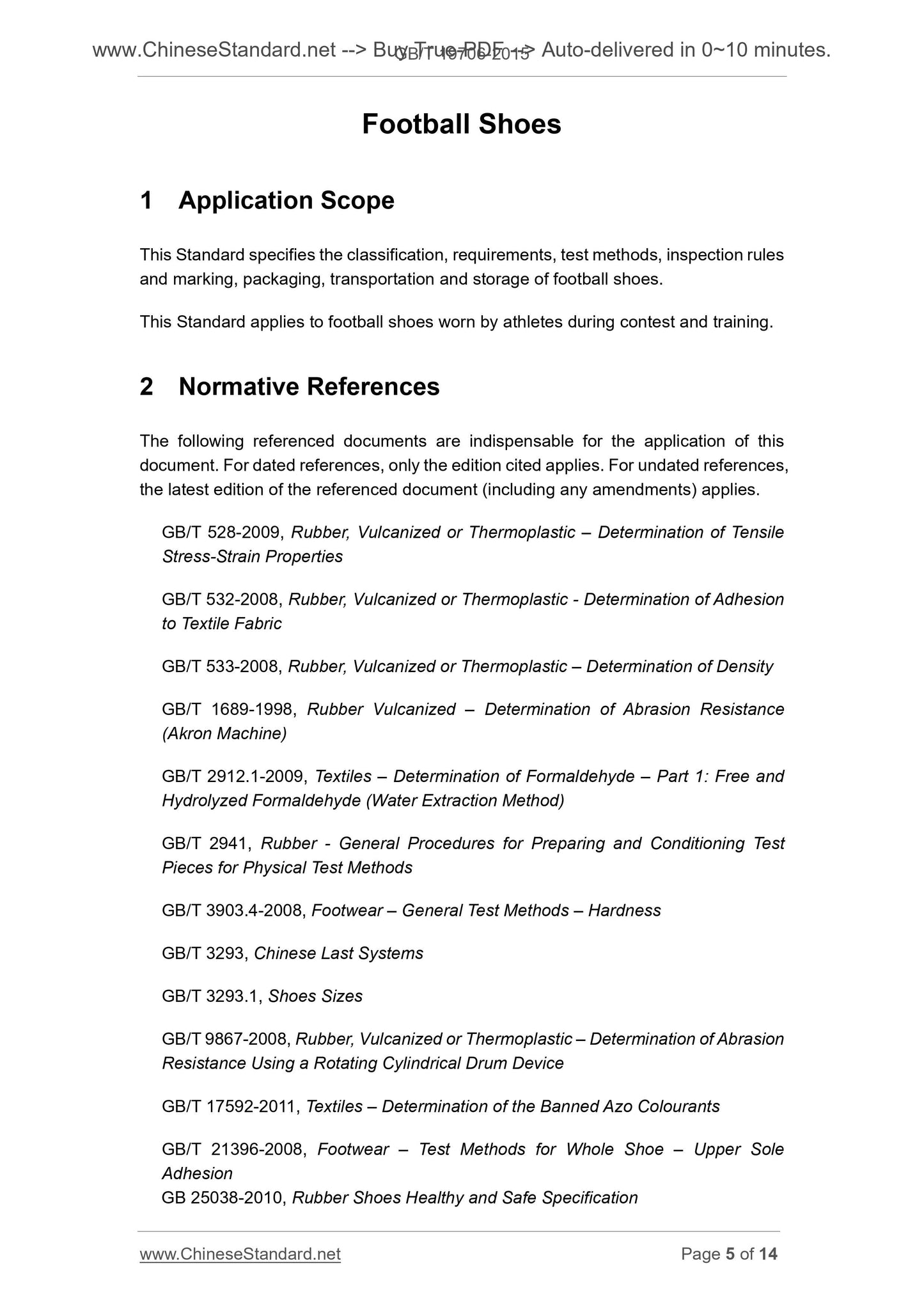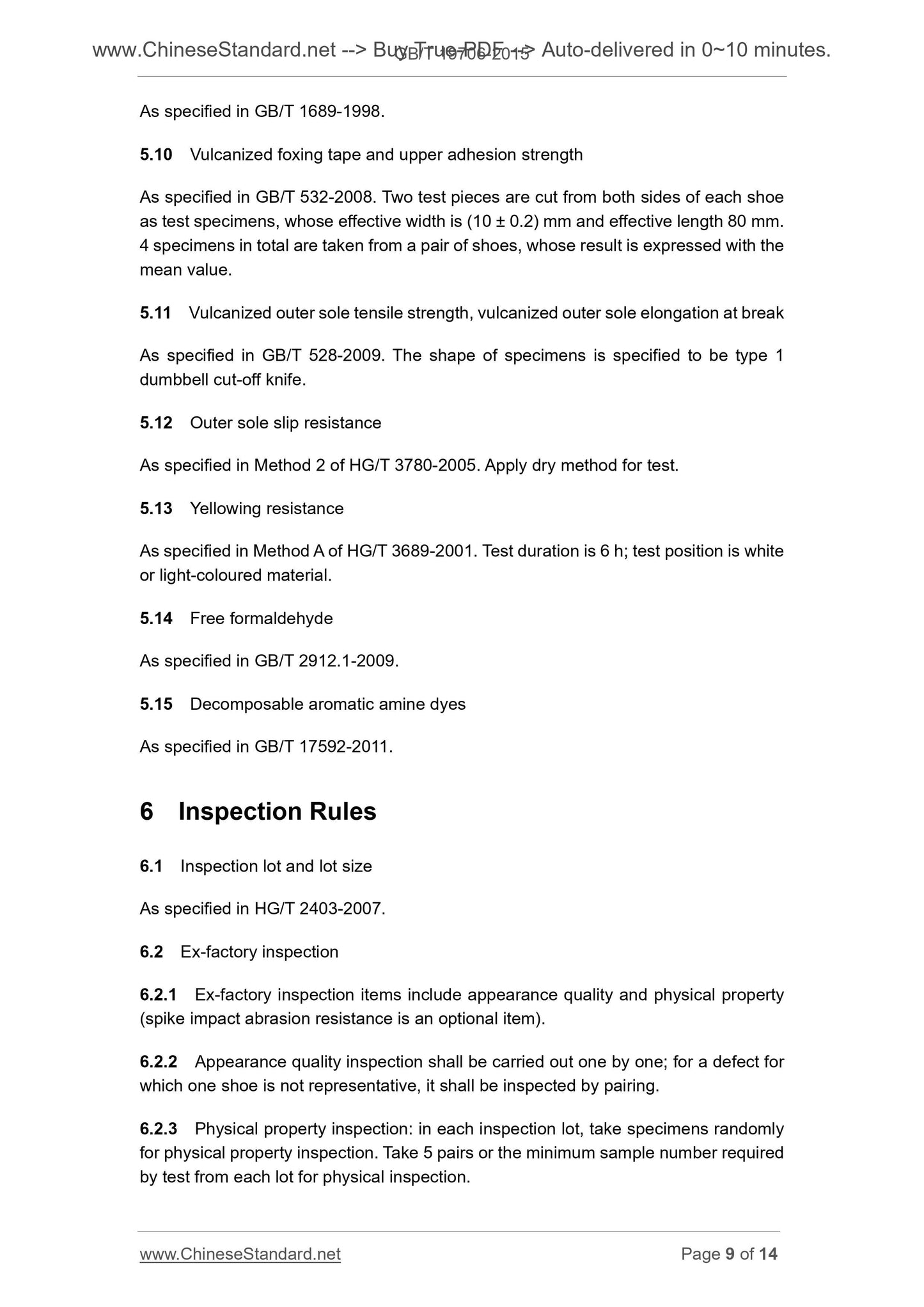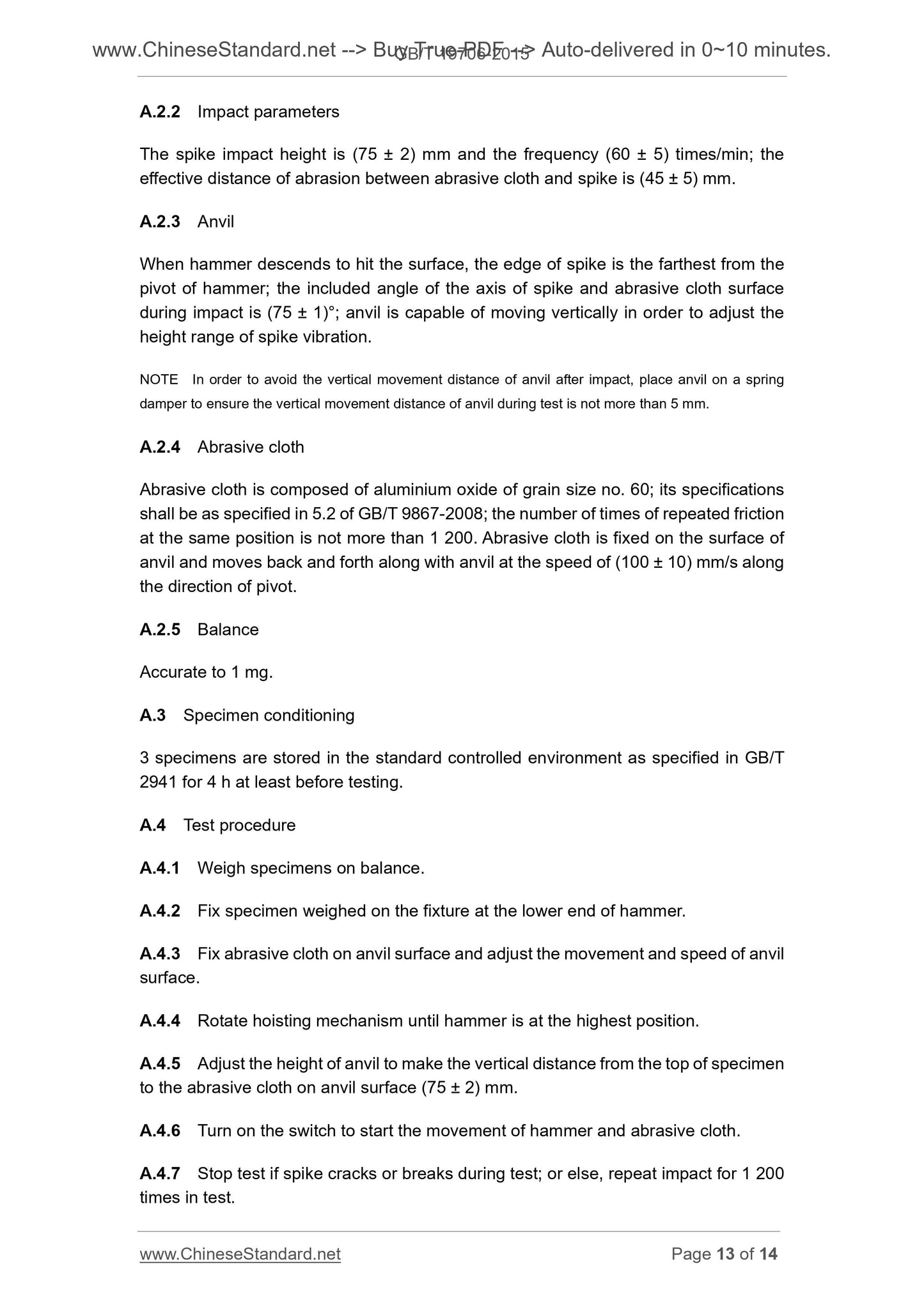1
/
of
6
PayPal, credit cards. Download editable-PDF and invoice in 1 second!
GB/T 19706-2015 English PDF (GB/T19706-2015)
GB/T 19706-2015 English PDF (GB/T19706-2015)
Regular price
$70.00 USD
Regular price
Sale price
$70.00 USD
Unit price
/
per
Shipping calculated at checkout.
Couldn't load pickup availability
Delivery: 3 seconds. Download true-PDF + Invoice.
Get QUOTATION in 1-minute: Click GB/T 19706-2015
Historical versions: GB/T 19706-2015
Preview True-PDF (Reload/Scroll if blank)
GB/T 19706-2015: Football shoes
GB/T 19706-2015
GB
NATIONAL STANDARD OF THE
PEOPLE’S REPUBLIC OF CHINA
ICS 61.060
Y 78
Replacing GB/T 19706-2005
Football Shoes
ISSUED ON. DECEMBER 31, 2015
IMPLEMENTED ON. JANUARY 1, 2017
Issued by. General Administration of Quality Supervision, Inspection and
Quarantine of the People's Republic of China;
Standardization Administration of the People's Republic of
China.
Table of Contents
Foreword ... 3
1 Application Scope ... 5
2 Normative References ... 5
3 Classification ... 6
4 Requirements ... 6
5 Test Methods ... 8
6 Inspection Rules ... 9
7 Marking, Packaging, Transportation, Storage ... 10
Annex A (Normative) Spike Impact Abrasion Resistance Test Method ... 12
Foreword
This Standard was drafted in accordance with the rules given in GB/T 1.1-2009.
This Standard replaces GB/T 19706-2005, Football Shoes. Compared with GB/T
19706-2005, Football Shoes, the major changes of this Standard are as follows.
-- it adds the classification of football shoes (see Article 3);
-- it modifies the requirements for appearance quality (see 4.2; 4.2 of edition 2005);
-- it deletes the requirements for upper sole peeling strength and adhesion strength
of outer sole and middle sole (see 4.4.1, 4.4.4 of edition 2005);
-- it adds the requirements for upper sole adhesion strength (see Table 2);
-- it deletes the requirements for abrasion mark (see 4.4.2 of edition 2005);
-- it adds the requirements for outer sole abrasion resistance (see Table 2);
-- it adds the requirements for spike impact abrasion resistance (see Table 2);
-- it modifies the requirements for whole shoe flexural property, outer sole hardness
and outer sole slip resistance (see Table 2; 4.4.3, 4.4.8, 4.4.10 of edition 2005);
-- it adds the requirements for outer sole density (see Table 2);
-- it adds the requirements for yellowing resistance (see Table 2);
-- it deletes the requirements for upper sole tensile strength of sewn football shoes
(see 4.4.11 of edition 2005);
-- it adds the requirements for healthy and safe properties (see 4.4);
-- it modifies inspection rules, marking, packaging, transportation, storage (see
Article 7; Article 7 of edition 2005).
This Standard was proposed by China Petroleum and Chemical Industry Federation.
This Standard shall be under the jurisdiction of Subcommittee on Rubber Shoes of
National Standardization Technical Committee on Rubber and Rubber Products
(SAC/TC 35/SC 9).
The drafting organizations of this Standard. Sems Industry Co., Ltd., Shanghai Warrior
Shoes Co., Ltd., Fujian Province Footwear Products Quality Supervision and
Inspection Centre, Fujian Quanzhou Peak Sports Products Co., Ltd., Fujian XPD
Sports Products Co., Ltd., Yeli Sports (China) Co., Ltd., Nike Sports (China) Co., Ltd.,
Jihua 3537 Shoe-making Co., Ltd., Xtep (China) Co., Ltd., Fujian Huafon New
Materials Corp., Ltd., Putian Haixi Footwear Industry R and D Centre.
Football Shoes
1 Application Scope
This Standard specifies the classification, requirements, test methods, inspection rules
and marking, packaging, transportation and storage of football shoes.
This Standard applies to football shoes worn by athletes during contest and training.
2 Normative References
The following referenced documents are indispensable for the application of this
document. For dated references, only the edition cited applies. For undated references,
the latest edition of the referenced document (including any amendments) applies.
GB/T 528-2009, Rubber, Vulcanized or Thermoplastic – Determination of Tensile
Stress-Strain Properties
GB/T 532-2008, Rubber, Vulcanized or Thermoplastic - Determination of Adhesion
to Textile Fabric
GB/T 533-2008, Rubber, Vulcanized or Thermoplastic – Determination of Density
GB/T 1689-1998, Rubber Vulcanized – Determination of Abrasion Resistance
(Akron Machine)
GB/T 2912.1-2009, Textiles – Determination of Formaldehyde – Part 1. Free and
Hydrolyzed Formaldehyde (Water Extraction Method)
GB/T 2941, Rubber - General Procedures for Preparing and Conditioning Test
Pieces for Physical Test Methods
GB/T 3903.4-2008, Footwear – General Test Methods – Hardness
GB/T 3293, Chinese Last Systems
GB/T 3293.1, Shoes Sizes
GB/T 9867-2008, Rubber, Vulcanized or Thermoplastic – Determination of Abrasion
Resistance Using a Rotating Cylindrical Drum Device
GB/T 17592-2011, Textiles – Determination of the Banned Azo Colourants
GB/T 21396-2008, Footwear – Test Methods for Whole Shoe – Upper Sole
Adhesion
GB 25038-2010, Rubber Shoes Healthy and Safe Specification
As specified in GB/T 1689-1998.
5.10 Vulcanized foxing tape and upper adhesion strength
As specified in GB/T 532-2008. Two test pieces are cut from both sides of each shoe
as test specimens, whose effective width is (10 ± 0.2) mm and effective length 80 mm.
4 specimens in total are taken from a pair of shoes, whose result is expressed with the
mean value.
5.11 Vulcanized outer sole tensile strength, vulcanized outer sole elongation at break
As specified in GB/T 528-2009. The shape of specimens is specified to be type 1
dumbbell cut-off knife.
5.12 Outer sole slip resistance
As specified in Method 2 of HG/T 3780-2005. Apply dry method for test.
5.13 Yellowing resistance
As specified in Method A of HG/T 3689-2001. Test duration is 6 h; test position is white
or light-coloured material.
5.14 Free formaldehyde
As specified in GB/T 2912.1-2009.
5.15 Decomposable aromatic amine dyes
As specified in GB/T 17592-2011.
6 Inspection Rules
6.1 Inspection lot and lot size
As specified in HG/T 2403-2007.
6.2 Ex-factory inspection
6.2.1 Ex-factory inspection items include appearance quality and physical property
(spike impact abrasion resistance is an optional item).
6.2.2 Appearance quality inspection shall be carried out one by one; for a defect for
which one shoe is not representative, it shall be inspected by pairing.
6.2.3 Physical property inspection. in each inspection lot, take specimens randomly
for physical property inspection. Take 5 pairs or the minimum sample number required
by test from each lot for physical inspection.
A.2.2 Impact parameters
The spike impact height is (75 ± 2) mm and the frequency (60 ± 5) times/min; the
effective distance of abrasion between abrasive cloth and spike is (45 ± 5) mm.
A.2.3 Anvil
When hammer descends to hit the surface, the edge of spike is the farthest from the
pivot of hammer; the included angle of the axis of spike and abrasive cloth surface
during impact is (75 ± 1)°; anvil is capable of moving vertically in order to adjust the
height range of spike vibration.
NOTE In order to avoid the vertical movement distance of anvil after impact, place anvil on a spring
damper to ensure the vertical movement distance of anvil during test is not more than 5 mm.
A.2.4 Abrasive cloth
Abrasive cloth is composed of aluminium oxide of grain size no. 60; its specifications
shall be as specified in 5.2 of GB/T 9867-2008; the number of times of repeated friction
at the same position is not more than 1 200. Abrasive cloth is fixed on the surface of
anvil and moves back and forth along with anvil at the speed of (100 ± 10) mm/s along
the direction of pivot.
A.2.5 Balance
Accurate to 1 mg.
A.3 Specimen conditioning
3 specimens are stored in the standard controlled environment as specified in GB/T
2941 for 4 h at least before testing.
A.4 Test procedure
A.4.1 Weigh...
Get QUOTATION in 1-minute: Click GB/T 19706-2015
Historical versions: GB/T 19706-2015
Preview True-PDF (Reload/Scroll if blank)
GB/T 19706-2015: Football shoes
GB/T 19706-2015
GB
NATIONAL STANDARD OF THE
PEOPLE’S REPUBLIC OF CHINA
ICS 61.060
Y 78
Replacing GB/T 19706-2005
Football Shoes
ISSUED ON. DECEMBER 31, 2015
IMPLEMENTED ON. JANUARY 1, 2017
Issued by. General Administration of Quality Supervision, Inspection and
Quarantine of the People's Republic of China;
Standardization Administration of the People's Republic of
China.
Table of Contents
Foreword ... 3
1 Application Scope ... 5
2 Normative References ... 5
3 Classification ... 6
4 Requirements ... 6
5 Test Methods ... 8
6 Inspection Rules ... 9
7 Marking, Packaging, Transportation, Storage ... 10
Annex A (Normative) Spike Impact Abrasion Resistance Test Method ... 12
Foreword
This Standard was drafted in accordance with the rules given in GB/T 1.1-2009.
This Standard replaces GB/T 19706-2005, Football Shoes. Compared with GB/T
19706-2005, Football Shoes, the major changes of this Standard are as follows.
-- it adds the classification of football shoes (see Article 3);
-- it modifies the requirements for appearance quality (see 4.2; 4.2 of edition 2005);
-- it deletes the requirements for upper sole peeling strength and adhesion strength
of outer sole and middle sole (see 4.4.1, 4.4.4 of edition 2005);
-- it adds the requirements for upper sole adhesion strength (see Table 2);
-- it deletes the requirements for abrasion mark (see 4.4.2 of edition 2005);
-- it adds the requirements for outer sole abrasion resistance (see Table 2);
-- it adds the requirements for spike impact abrasion resistance (see Table 2);
-- it modifies the requirements for whole shoe flexural property, outer sole hardness
and outer sole slip resistance (see Table 2; 4.4.3, 4.4.8, 4.4.10 of edition 2005);
-- it adds the requirements for outer sole density (see Table 2);
-- it adds the requirements for yellowing resistance (see Table 2);
-- it deletes the requirements for upper sole tensile strength of sewn football shoes
(see 4.4.11 of edition 2005);
-- it adds the requirements for healthy and safe properties (see 4.4);
-- it modifies inspection rules, marking, packaging, transportation, storage (see
Article 7; Article 7 of edition 2005).
This Standard was proposed by China Petroleum and Chemical Industry Federation.
This Standard shall be under the jurisdiction of Subcommittee on Rubber Shoes of
National Standardization Technical Committee on Rubber and Rubber Products
(SAC/TC 35/SC 9).
The drafting organizations of this Standard. Sems Industry Co., Ltd., Shanghai Warrior
Shoes Co., Ltd., Fujian Province Footwear Products Quality Supervision and
Inspection Centre, Fujian Quanzhou Peak Sports Products Co., Ltd., Fujian XPD
Sports Products Co., Ltd., Yeli Sports (China) Co., Ltd., Nike Sports (China) Co., Ltd.,
Jihua 3537 Shoe-making Co., Ltd., Xtep (China) Co., Ltd., Fujian Huafon New
Materials Corp., Ltd., Putian Haixi Footwear Industry R and D Centre.
Football Shoes
1 Application Scope
This Standard specifies the classification, requirements, test methods, inspection rules
and marking, packaging, transportation and storage of football shoes.
This Standard applies to football shoes worn by athletes during contest and training.
2 Normative References
The following referenced documents are indispensable for the application of this
document. For dated references, only the edition cited applies. For undated references,
the latest edition of the referenced document (including any amendments) applies.
GB/T 528-2009, Rubber, Vulcanized or Thermoplastic – Determination of Tensile
Stress-Strain Properties
GB/T 532-2008, Rubber, Vulcanized or Thermoplastic - Determination of Adhesion
to Textile Fabric
GB/T 533-2008, Rubber, Vulcanized or Thermoplastic – Determination of Density
GB/T 1689-1998, Rubber Vulcanized – Determination of Abrasion Resistance
(Akron Machine)
GB/T 2912.1-2009, Textiles – Determination of Formaldehyde – Part 1. Free and
Hydrolyzed Formaldehyde (Water Extraction Method)
GB/T 2941, Rubber - General Procedures for Preparing and Conditioning Test
Pieces for Physical Test Methods
GB/T 3903.4-2008, Footwear – General Test Methods – Hardness
GB/T 3293, Chinese Last Systems
GB/T 3293.1, Shoes Sizes
GB/T 9867-2008, Rubber, Vulcanized or Thermoplastic – Determination of Abrasion
Resistance Using a Rotating Cylindrical Drum Device
GB/T 17592-2011, Textiles – Determination of the Banned Azo Colourants
GB/T 21396-2008, Footwear – Test Methods for Whole Shoe – Upper Sole
Adhesion
GB 25038-2010, Rubber Shoes Healthy and Safe Specification
As specified in GB/T 1689-1998.
5.10 Vulcanized foxing tape and upper adhesion strength
As specified in GB/T 532-2008. Two test pieces are cut from both sides of each shoe
as test specimens, whose effective width is (10 ± 0.2) mm and effective length 80 mm.
4 specimens in total are taken from a pair of shoes, whose result is expressed with the
mean value.
5.11 Vulcanized outer sole tensile strength, vulcanized outer sole elongation at break
As specified in GB/T 528-2009. The shape of specimens is specified to be type 1
dumbbell cut-off knife.
5.12 Outer sole slip resistance
As specified in Method 2 of HG/T 3780-2005. Apply dry method for test.
5.13 Yellowing resistance
As specified in Method A of HG/T 3689-2001. Test duration is 6 h; test position is white
or light-coloured material.
5.14 Free formaldehyde
As specified in GB/T 2912.1-2009.
5.15 Decomposable aromatic amine dyes
As specified in GB/T 17592-2011.
6 Inspection Rules
6.1 Inspection lot and lot size
As specified in HG/T 2403-2007.
6.2 Ex-factory inspection
6.2.1 Ex-factory inspection items include appearance quality and physical property
(spike impact abrasion resistance is an optional item).
6.2.2 Appearance quality inspection shall be carried out one by one; for a defect for
which one shoe is not representative, it shall be inspected by pairing.
6.2.3 Physical property inspection. in each inspection lot, take specimens randomly
for physical property inspection. Take 5 pairs or the minimum sample number required
by test from each lot for physical inspection.
A.2.2 Impact parameters
The spike impact height is (75 ± 2) mm and the frequency (60 ± 5) times/min; the
effective distance of abrasion between abrasive cloth and spike is (45 ± 5) mm.
A.2.3 Anvil
When hammer descends to hit the surface, the edge of spike is the farthest from the
pivot of hammer; the included angle of the axis of spike and abrasive cloth surface
during impact is (75 ± 1)°; anvil is capable of moving vertically in order to adjust the
height range of spike vibration.
NOTE In order to avoid the vertical movement distance of anvil after impact, place anvil on a spring
damper to ensure the vertical movement distance of anvil during test is not more than 5 mm.
A.2.4 Abrasive cloth
Abrasive cloth is composed of aluminium oxide of grain size no. 60; its specifications
shall be as specified in 5.2 of GB/T 9867-2008; the number of times of repeated friction
at the same position is not more than 1 200. Abrasive cloth is fixed on the surface of
anvil and moves back and forth along with anvil at the speed of (100 ± 10) mm/s along
the direction of pivot.
A.2.5 Balance
Accurate to 1 mg.
A.3 Specimen conditioning
3 specimens are stored in the standard controlled environment as specified in GB/T
2941 for 4 h at least before testing.
A.4 Test procedure
A.4.1 Weigh...
Share
